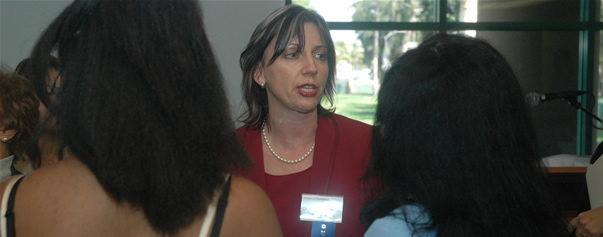Engineers: Shortage Could Become Crisis
Associate Dean and Sociologist Look for Solutions
March 12, 2007
By Russ Hudson
There is a shortage of engineers of nearly all types.
There is little debate that this is a state, nation and global issue. As recently as March 1, KFWB radio reporter Penny Griego told listeners that Southern California Edison had instituted an intensive campaign to find, hire and retain engineers, a campaign necessitated by the utility industry’s growing needs versus a shrinking pool of engineers.
The Hindu, the national newspaper of India, reported Feb. 12 a call to produce more employable engineers.
And Yorkshire Forward, one of nine regional development agencies set up by the English government, reported in October that at least 3,000 more engineers would be needed in the next five years by the United Kingdom’s petroleum and gas industry alone.
The need is expected to grow, and educators as well as those in the industry are wondering what to do before it becomes a crisis.
Dorota Huizinga believes she has one possible solution. The associate dean of the College of Engineering and Computer Science says to solve the engineering gap, we must first solve the gender gap.
That is what she told Women and Philanthropy, a group of high achievers and opinion leaders, in a recent address “The Obstacle Course Leading to a Career in Engineering and Technology: Gender Inequity in Engineering and Computer Science” given in tandem with Eileen Walsh, assistant professor of sociology.
“In 1980, eight percent of college graduates were engineers,” said Huizinga. “The need has grown tremendously since, but in 2005 only five percent of graduates were engineers. And an even smaller percent of those were women in 2005 than in 1980.”
At CSUF, women outrank men on campus — 59 vs. 41 percent, she said, pointing out that similar percentages can be seen nationally. But, in engineering, only 15 percent are women, which also mimics statistics nationally.
Why Aren’t Women Seeking Engineering Careers?
“Why is this happening?” she asked. “First, for both men and women, but especially women, there is the negative image of engineers being geeks with slide rules and calculators. Not true.
“Next, studies indicate that women and girls are more interested than men in doing work that is altruistic. That is why the bulk of women in engineering are in environmental engineering. Also, girls and women tend to want to work with other people, but see engineering as primarily data exchange. Not true.
“Next,” said Huizinga, “most engineering faculty are men. They often communicate differently than women. Some also may have a different level of social skills. Society makes it more permissible for men to focus on the technical aspects of a job, whereas girls and women, who want to be more altruistic, are better able to interface with the ‘outside world.’
“Because of that, women may try to make the software interface easier and more intuitive for users than a male focusing only on the technical possibilities would. But, in the male-dominated educational milieu and in the male-dominated engineering professions, better interfaces with users, more easily understood documentation, and more user-friendly applications are simply not as valued” as adding another technical feature, even if it is something that may not get much use.
“My husband works in the industry,” Huizinga recounted to the group. “I posed the question to him, ‘After all these years, why is there no purse holder for women in automobiles?’ He smiled and said, ‘There is one. It’s called a seat.’ I responded, ‘No, not really. When I hit the brakes, it’s called a floor!’”
Changing the Playing Field
Huizinga and many others in engineering and computer science are working to get the word out about what engineering really is, how altruistic it is, she said. One such effort, she noted is the Johns Hopkins What is Engineering program — an effort to interest high school students in the field.
Other efforts are being developed with the support of grants.
The grants, Walsh said, include two that would support outreach efforts to get information to high school students about engineering and possible careers before they’ve decided it isn’t for them for reasons unrelated to their abilities. One is called PACE — Promoting Access to Careers in Engineering — the other is Youth Scholars.
“We need to get across how creative engineering can be,” Walsh said, citing iMAX movie screens and medical equipment as examples. “Also, so much of engineering is taught in lecture form rather than with projects and problem solving.
“Another thing we’ve learned, related to how women’s interests don’t always match what is valued in the male-dominated profession: Women who leave engineering, feeling they just aren’t doing well, are usually doing as well as the ones who stay. But, because what they’re doing isn’t valued as much, they feel they’re failing. In some cases, they’ve been ignored or even harassed.
“We would like to reach out to youths,” said Walsh, “using problem-solving. In one instance, we give the group a scenario of a disaster, and they must manage it. They must get supplies to affected areas, including planning air drops, if that is the viable option. They have to get people out, including the injured. And they have to plan to rebuild the infrastructure. It’s an eye-opener and promotes teamwork.”
Walsh finished by naming one more problem that must be addressed. “Through research, sociologists have learned that the kids themselves, at a fairly early age, build barriers between genders,” she said, citing Barrie Thorne’s “Gender Play: Girls and Boys in School.”
“They do that without adult encouragement. In fact, they can do it even when adults are making a specific effort to be egalitarian. We have to learn how to address that, too.”


